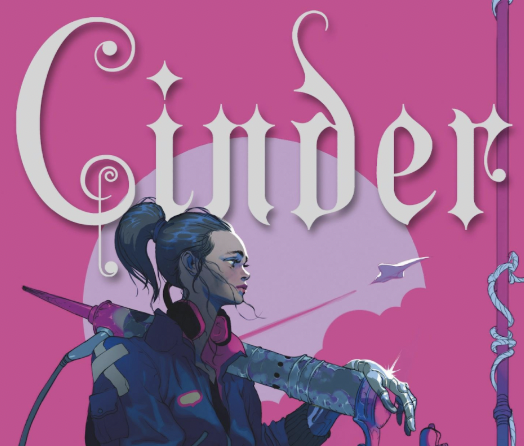
Editors’ note: Sharon High seniors enrolled in Honors Advanced Print & Digital Journalism are writing reviews of books available in the Sharon High School Library catalog. Arthur Do shares his opinions about a sci-fi dystopian fairytale loosely based upon the Cinderella story.
What if your favorite fairy tale was reimagined into a futuristic dystopian world? I’ve never been a big fan of sci-fi; it’s just that robots, super intelligent evil people, and overly technical words never caught my attention. That is, until I met Cinder at my local Barnes & Noble; the book also is available in the Sharon High School Library.
Inspired by her participation in the 2008 Aria’s Ink short story contest, Marissa Meyer wrote Cinder, her debut novel in 2012, which led her to create a six-book series called The Lunar Chronicles. The series consists of six books: Cinder, Scarlet, Cress, Winter, and two others that follow different storylines. In this review, we will focus on the first book, Cinder.
Cinder is set in a futuristic, post-World War IV Earth, primarily in New Beijing, the capital of the Eastern Commonwealth. At first glance, this high-tech world—with cyborgs, androids, and hovering cars—might seem like a super progressive utopia. However, beneath the surface lies a harsh reality: cyborgs and robots are heavily discriminated against, often made as servants and even exploited as test subjects in humanity’s desperate search for a cure to letumosis, a deadly pandemic ravaging the planet. To make matters worse, Earth faces the looming threat of invasion by Queen Levana, the manipulative and ruthless ruler of the Moon’s colony.
The protagonist, Cinder, is a cyborg and the most skilled mechanic in New Beijing. Cinder lives with her cruel stepmother, Linh Adri, and two stepsisters, Pearl and Peony—sounds familiar, right? That’s because Cinder is inspired by the classic tale “Cinderella.” Ever since Cinder was adopted, she has been met with disgust because of her cyborg parts. Her aunt and stepsister, Pearl, treat her as nothing more than a servant and give her the bare minimum to survive.
But then Cinder’s life changes when one day Kai, the charming prince of the Eastern Commonwealth, stumbles into her mechanic shop seeking her help to repair his broken android. Little does Cinder know that this simple task will lead to a fateful ball dance with the prince, becoming a space fugitive, and unmasking the deadly origins of the Lunars.
I’ve read countless books over 400 pages and, countless times, wanted to toss them out the window because they felt too long. Yet Cinder and the entire series, each over 400 pages, managed to keep me hooked despite my low attention span.
Meyer does an outstanding job making her characters feel real. Her style of dialogue and the interactions her characters have are incredibly entertaining and relatable. For example, when Prince Kai first meets Cinder, their exchange feels so natural: “‘Maybe, um…’ Kai pulled his fingers across his lips ‘—on the highness stuff?’ ‘Right. Of course. How—can I—are you—’ [Cinder] swallowed, the words sticking like bean paste to her tongue.” Kai covering his lips instead of speaking is such a creative way to show his motives. Readers can visualize his efforts in trying to hide his identity. Additionally, Cinder’s stuttering makes the moment even better—it’s so relatable. You can tell she never expected to meet the Prince of the Commonwealth, let alone have him ask for her help. Meyer’s writing style makes you feel what the characters are feeling. Seeing Cinder stutter during her first impression with Kai makes you want to slap your face and hide yourself in embarrassment. Meyer doubles down on the embarrassment when she describes how every coherent word was just stuck on Cinder’s tongue like paste, so she’s just there, staring at him.
Meyer’s use of vivid imagery shows the reader what’s going on instead of just telling them; that’s what makes Cinder so interesting. Like, in the beginning of the book, we find out that Cinder is a cyborg not because Meyer tells us, but because she shows us. For example, “The screw through Cinder’s ankles had rusted, the engraved cross marks worn to a mangled circle… By the time it was extracted, it was far enough for her to wrench free with her prosthetic steel hand.” At the beginning, readers learn that Cinder has a robot foot and she has a prosthetic hand. Meyer describes Cinder’s robotic physical appearance just enough so that we can deduce she doesn’t look human. Meyer later on shows how Cinder doesn’t perceive things like humans do when she writes, “Her retina display scanned his features… details scribbled across the bottom of her vision in a stream of green text.” In the beginning of the book, Meyer not once writes that Cinder is a cyborg, but it’s through her description of Cinder, her actions, and how she perceives the world that we have an “aha moment” and realize she’s a cyborg.
If you’ve never really been into sci-fi books, I’d absolutely recommend Cinder. Reading it doesn’t feel like you’re reading sci-fi, even though it is. Science and fantasy, two seemingly opposite genres, blend together effortlessly—like oil and water becoming one. Meyer weaves the possible and the impossible in a way that feels natural. Her vivid imagery is so well-crafted that it allows readers to truly understand the characters—their motives and decisions—without feeling like it’s being shoved down your throat. So there it is, my review of Cinder. I promise it won’t feel like a chore; just the first few chapters will leave you craving for more, but don’t worry. Cinder is only the first book.
Cinder
By Marrisa Meyer
Feiwell & Friends, 390 pp., $11.69